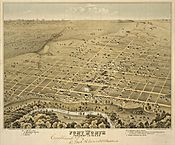Hell's Half Acre (Fort Worth) facts for kids
Quick facts for kids Hell's Half Acre (Fort Worth) |
|
|---|---|
| Lua error in Module:Location_map at line 420: attempt to index field 'wikibase' (a nil value). | |
| Location | Tarrant County, Texas |
| Nearest city | Fort Worth, Texas |
| Area | .5 acres (0.20 ha) |
| Elevation | 610 feet (190 m) |
| Formed | 1870s |
| Governing body | State of Texas |
| Official name: Hell's Half Acre - Tarrant County - Fort Worth | |
| Designated | 1993 |
| Marker Number | 2431 |
| Atlas Number | 5439002431 |
Hell's Half Acre was a well-known area in Fort Worth, Texas. It was sometimes called the "Bloody Third Ward" because it was a very busy and sometimes wild part of town.
What Was Hell's Half Acre?
In the 1870s, Hell's Half Acre grew as a popular stop for cowboys moving cattle from Texas to Kansas. It soon had many places for entertainment and lodging. This area stretched from Tenth Street to Fifteenth Street, crossing Houston, Main, and Rusk Streets. Throckmorton and Calhoun streets marked its edges.
At its busiest, Hell's Half Acre had many boarding houses, places to play games, hotels, and saloons. It became a place where some famous Old West figures were seen. These included Bat Masterson, Butch Cassidy, Doc Holliday, Etta Place, Luke Short, Sam Bass, Sundance Kid, and Wyatt Earp.
Law and Order in the Acre
Even though there were many activities that were not allowed, law enforcement often did not get involved. The Acre brought a lot of money to Fort Worth. City officials were slow to act, even with pressure from outside groups.
The city's most famous saloon was the White Elephant. It was just outside the Acre. This place was known for its fancy style and live shows. It was also known for its exciting events.
Changes Over Time
In 1889, after some serious events in the city, officials began to close down certain activities. These were the ones that caused the most trouble. By the early 1900s, fewer visitors came to the Acre.
A movement called the Progressive movement also put more pressure on the area. By 1919, Fort Worth's "Third Ward" was no longer known as a wild place. This was thanks to the efforts of law enforcement like Jim Courtright. It was also due to the speeches of John Franklyn Norris.


